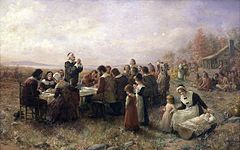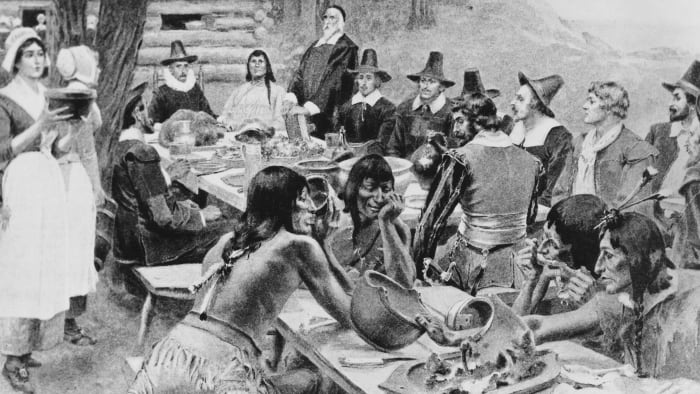Colonists at the First Thanksgiving were Mostly Men
Because Most Women Had Perished
from History.com
 As families around the country prepare to gather with family, eat turkey and perhaps partake in some Black Friday shopping, they might be surprised to learn how much we don’t know about the origins of the Thanksgiving.
Nearly all of what historians have learned about the first Thanksgiving comes from a single eyewitness report: a letter written in December 1621 by Edward Winslow, one of the 100 or so people who sailed from England aboard the Mayflower in 1620 and founded Plymouth Colony in Massachusetts. William Bradford, Plymouth’s governor in 1621, wrote briefly of the event in Of Plymouth Plantation, his history of the colony, but that was more than 20 years after the feast itself.
According to this account, the historic event didn’t happen on the fourth Thursday in November, as it does today—and it wasn’t known as Thanksgiving. In fact, it took place over three days sometime between late September and mid-November in 1621, and was considered a harvest celebration.
“Basically it was to celebrate the end of a successful harvest,” says Tom Begley, the executive liaison for administration, research and special projects at Plimoth Plantation. “The three-day celebration included feasting, games and military exercises, and there was definitely an amount of diplomacy between the colonists and the native attendees as well.”
It was a feast for a young crowd.
As families around the country prepare to gather with family, eat turkey and perhaps partake in some Black Friday shopping, they might be surprised to learn how much we don’t know about the origins of the Thanksgiving.
Nearly all of what historians have learned about the first Thanksgiving comes from a single eyewitness report: a letter written in December 1621 by Edward Winslow, one of the 100 or so people who sailed from England aboard the Mayflower in 1620 and founded Plymouth Colony in Massachusetts. William Bradford, Plymouth’s governor in 1621, wrote briefly of the event in Of Plymouth Plantation, his history of the colony, but that was more than 20 years after the feast itself.
According to this account, the historic event didn’t happen on the fourth Thursday in November, as it does today—and it wasn’t known as Thanksgiving. In fact, it took place over three days sometime between late September and mid-November in 1621, and was considered a harvest celebration.
“Basically it was to celebrate the end of a successful harvest,” says Tom Begley, the executive liaison for administration, research and special projects at Plimoth Plantation. “The three-day celebration included feasting, games and military exercises, and there was definitely an amount of diplomacy between the colonists and the native attendees as well.”
It was a feast for a young crowd.
 Just over 50 colonists are believed to have attended, including 22 men, four married women—including Edward Winslow’s wife—and more than 25 children and teenagers. These were the lucky ones who had made it through a rough entry into the New World, including a harsh winter during which an epidemic of disease swept through the colony, felling nearly half the original group. Some 78 percent of the women who had arrived on the Mayflower had died during the first winter, a far higher percentage than for men or children. “For the English, [the first Thanksgiving] was also celebrating the fact that they had survived their first year here in New England,” Begley points out.
The Plymouth colonists were likely outnumbered more than two-to-one at the event by their Native American counterparts. Winslow’s account records “many of the Indians coming amongst us, and amongst the rest their greatest king Massasoit, with some ninety men.” Massasoit (who was actually named Ousemequin) was the sachem (leader) of the Pokanoket Wampanoag, a local Native American society that had begun dealings with the colonists earlier in 1621.
“We don't know for sure how it came about that they were there,” Begley says of the Native Americans at the first Thanksgiving. “Some native historians have suggested that Massasoit and his men were in the area anyways, because at the end of the harvest was when they typically made their diplomatic rounds to other native groups. Also, Massasoit commented to the Pilgrims in March of 1621 that they would be back to plant the corn on the south side of what we know as Town Brook in Plymouth. So he still recognizes that there are some planting grounds that are his peoples’ in Plymouth.”
Just over 50 colonists are believed to have attended, including 22 men, four married women—including Edward Winslow’s wife—and more than 25 children and teenagers. These were the lucky ones who had made it through a rough entry into the New World, including a harsh winter during which an epidemic of disease swept through the colony, felling nearly half the original group. Some 78 percent of the women who had arrived on the Mayflower had died during the first winter, a far higher percentage than for men or children. “For the English, [the first Thanksgiving] was also celebrating the fact that they had survived their first year here in New England,” Begley points out.
The Plymouth colonists were likely outnumbered more than two-to-one at the event by their Native American counterparts. Winslow’s account records “many of the Indians coming amongst us, and amongst the rest their greatest king Massasoit, with some ninety men.” Massasoit (who was actually named Ousemequin) was the sachem (leader) of the Pokanoket Wampanoag, a local Native American society that had begun dealings with the colonists earlier in 1621.
“We don't know for sure how it came about that they were there,” Begley says of the Native Americans at the first Thanksgiving. “Some native historians have suggested that Massasoit and his men were in the area anyways, because at the end of the harvest was when they typically made their diplomatic rounds to other native groups. Also, Massasoit commented to the Pilgrims in March of 1621 that they would be back to plant the corn on the south side of what we know as Town Brook in Plymouth. So he still recognizes that there are some planting grounds that are his peoples’ in Plymouth.”
READ MORE: Why Did the Pilgrims Come to America?The first feast was also about giving thanks.
 While the 1621 event may not have been called Thanksgiving, the sentiment was certainly present in that historic celebration, just as it would play a defining role in how the tradition developed over the centuries to come.
“Giving thanks is really an important part of both cultures,” Begley says. “For the English, before and after every meal there was a prayer of thanksgiving. For something on this scale, celebrating a successful harvest, there definitely would have been moments of giving thanks to their God.”
For the Native Americans at the first Thanksgiving, giving thanks was a daily part of life. “We as native people [traditionally] have thanksgivings as a daily, ongoing thing," Linda Coombs, the former associate director of the Wampanoag program at Plimoth Plantation, told the Christian Science Monitor. "Every time anybody went hunting or fishing or picked a plant, they would offer a prayer or acknowledgment."
While the 1621 event may not have been called Thanksgiving, the sentiment was certainly present in that historic celebration, just as it would play a defining role in how the tradition developed over the centuries to come.
“Giving thanks is really an important part of both cultures,” Begley says. “For the English, before and after every meal there was a prayer of thanksgiving. For something on this scale, celebrating a successful harvest, there definitely would have been moments of giving thanks to their God.”
For the Native Americans at the first Thanksgiving, giving thanks was a daily part of life. “We as native people [traditionally] have thanksgivings as a daily, ongoing thing," Linda Coombs, the former associate director of the Wampanoag program at Plimoth Plantation, told the Christian Science Monitor. "Every time anybody went hunting or fishing or picked a plant, they would offer a prayer or acknowledgment."
Author: Sarh Pruitt
Website Name: HISTORY,
Article URL: https://www.history.com/news/first-thanksgiving-colonists-native-americans-men
Last Updated: November 16, 2020
Original Published Date: November 16, 2018